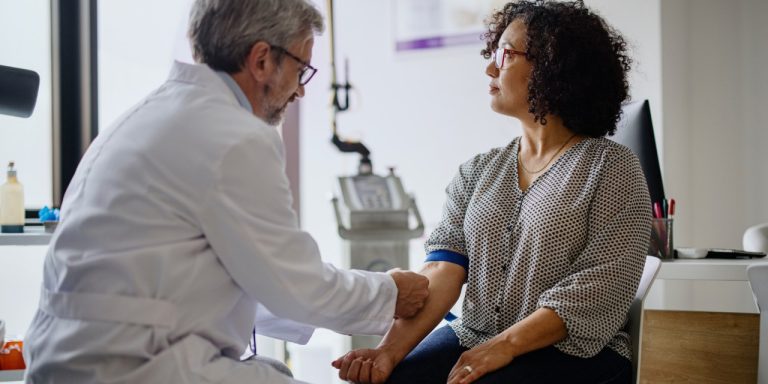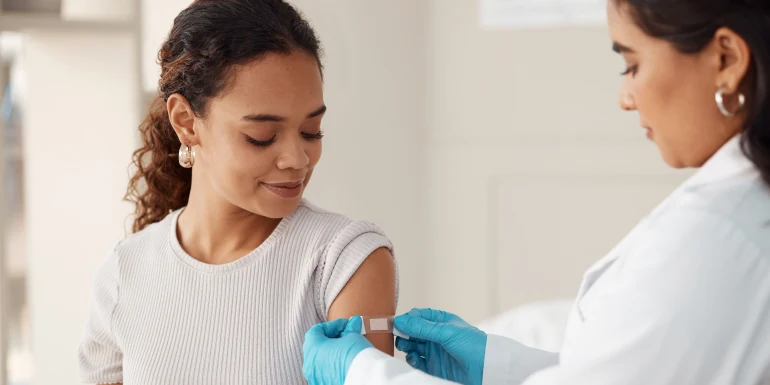
STI tests for men and women
How do healthcare professionals test for syphilis? At what stage are pathogens detectable? How is a urethral swab used to diagnose sexually transmitted diseases? Which STI tests do doctors offer for men and women? Find out more here.
Sexually transmitted diseases: definition
Specialists talk about STDs (sexually transmitted diseases) and STIs (sexually transmitted infections). Sexually transmitted diseases are caused by pathogens like viruses, bacteria or parasites and they affect both men and women. People who have many sexual partners are at increased risk.
How exactly are STIs transmitted? Those affected generally pass on the pathogens via sperm, vaginal secretions or blood. STIs can sometimes be transmitted through close skin contact too.
There is a risk of catching sexually transmitted infections via oral intercourse too, but this risk is less than for vaginal or anal intercourse. The infections most commonly associated with oral intercourse are syphilis, gonorrhoea and genital herpes (herpes simplex). There’s also a moderate risk of infection with HPV (human papillomavirus).
What sexually transmitted diseases are there?
There are various different sexually transmitted diseases that occur in men and women. The most common are:
- Human immunodeficiency virus (HIV) infection
- Chlamydia
- Gonorrhoea
- Syphilis
- Genital herpes
- HPV (causes genital warts)
- Hepatitis B and C
- Trichomoniasis infection
Do fungal infections count as a typical sexually transmitted infection? No, these are usually triggered by yeasts within the body. An imbalance or increase in these might be the result of weakened immune defences.
However, it is possible to transmit genital fungal infections to sexual partners – just like common sexually transmitted diseases. So a test for fungal infection and open communication with your partner are particularly important where this is suspected. This will ensure you prevent any potential infection. Your gynaecologist or urologist will offer the relevant tests.
Some sexually transmitted infections are viral, e.g. genital herpes, hepatitis B, genital warts or HIV infections. The viruses triggering them usually remain in the affected individual’s body for life. Nonetheless, these sexually transmitted diseases can be treated effectively. Take HIV patients, for example: the limitations on their life expectancy and quality of life are minimal.
Detecting sexually transmitted diseases – possible symptoms
The symptoms caused by a sexually transmitted disease depend on the type of disease and the stage it is at. The most common symptoms of sexually transmitted diseases include:
- Skin changes such as redness, rashes, ulcers and blisters, possibly associated with itching
- Abdominal pains
- Aching limbs and groin
- Pain during intercourse
- Burning sensation when urinating
- Fever
- Lymph node swelling
- In women: burning sensation in the vagina and discharge
Note: itching, rashes and other skin changes associated with STDs may also occur outside of the genital area. In some cases, specific parts of the body are affected.
If you notice one or more of these symptoms, talk to your doctor. They can perform an STD test and give you a diagnosis.
Sexually transmitted diseases: common tests
Different sexually transmitted diseases require different tests. Specialists can detect some pathogens with a swab, others with a blood test. Talk to your GP about a potential STD test. Alternatively you can find out about them from your gynaecologist or urologist directly. Hospitals offer STD testing, too.
Basic insurance will cover the costs of an STI test if your doctor orders the test for the purposes of diagnosing a suspected STI. Health insurance will cover the costs where this is necessary for medical treatment. Testing is not anonymous.
Good to know: if you have different sexual partners, specialists recommend that you undergo regular STI testing – regardless of whether you have any symptoms. In such cases, you will have to cover the costs yourself. How much does an HIV test or any other method of diagnosis cost? It depends on what the testing is for. Generally speaking, the more STIs a specialist tests for simultaneously, the more expensive it is.
HIV test
STI tests for HIV are performed by gynaecologists, GPs and AIDS counselling services. But how does HIV testing work? The test for HIV is a blood test. Initially, doctors detect this STI using antibodies. These form in the body anywhere from two to ten weeks after an infection. If these antibodies are present in the blood, the HIV test is positive. Important: if the HIV test is negative, this does not rule out prior infection. That’s because specialists cannot detect antibodies in the blood until around three months afterwards.
After a positive result, an STI test for antigens is performed. These are special virus proteins which are not detectable in the blood until around six weeks after infection with HIV. If this STI test is positive too, the affected individual is HIV positive.
Good to know: rapid HIV tests are also available. You can get these from a pharmacy. This test must be performed according to the instructions on the package insert. What can distort a home HIV test? Tests without a European CE marking may display an incorrect result, so make sure you use a CE-certified test. If you get a positive result from one of these tests, contact a doctor or a test centre. A specialist there will carry out another test to confirm or refute the result of the home test.
Chlamydia test
Speak to your gynaecologist or your urologist directly if you think you may have the STI chlamydia. The test for this STI starts with a physical examination, where the specialist checks for rashes, discharge and swollen lymph nodes.
This STI is diagnosed by means of a swab of the urethra or the cervix. For men, the doctor inserts a sterile cotton swab into the urethra. This is roughly 20 to 25 centimetres long and stops at the top of the penis. The doctor will then perform the STI test on the basis of the urethral secretion. To detect this STI in women, the specialist inserts a small spatula into the vagina up to the cervix, where they take a sample of small mucosal cells.
A urine sample may give an indication of potential pathogens too.
This STI test may also be carried out using a blood sample, where the doctor will check whether you have antibodies in your blood. Since the body does not form antibodies until after a certain amount of time, these will not be detectable until a few weeks afterwards.
Gonorrhoea test
Likewise, in the STI test for gonorrhoea, the doctor takes a swab of the urethra or the cervix. To obtain a clear diagnosis and to detect any potential antibiotic resistance, they usually cultivate a bacterial culture with the pathogens. For men, a urine sample may also be taken.
Syphilis test
Doctors often use secretions from weeping skin lesions to detect syphilis. They test these for the DNA of the causative bacteria using a syphilis PCR test. Blood samples can be used for the syphilis test too. How long should those affected wait? Ideally, they should wait up to three months after infection, because specialists may not find antibodies in the blood until then.
The blood test may be negative even though you have typical syphilis symptoms. In such cases, your doctor will advise you to repeat the STI test after four weeks.
Genital herpes test
Urologists and gynaecologists perform this STI test by taking a swab of the affected skin area. This sample will contain the herpes viruses causing the condition.
In some cases specialists will also use blood tests, where they test the blood sample for herpes antibodies. However, these aren’t detectable until some time later.
Genital warts test
Specialists perform the STI test for genital warts by checking and palpating the affected areas. For men, they often perform a urethral endoscopy in addition. In some cases, a proctoscope may be used to examine the intestine as well.
For women, too, the medical specialist will palpate the affected areas and inspect them with a little mirror. A Pap smear will then generally be carried out. This is not normally used directly for STI diagnosis, but doctors use it to detect any potential cell changes that might occur after HP viruses. These are the viruses responsible for genital warts.
Hepatitis B test
Doctors generally take a blood sample to detect a potential hepatitis B infection. In this STI test, they test the blood for antibodies, antigens and virus DNA.
If, for example, they found HB antigens in the sample, this would indicate an ongoing infection. Anti-HB antibodies, conversely, suggest a past infection.
Trichomoniasis test
Doctors test for the STI trichomoniasis using swabs of the urethra, the vagina and the anus. In some cases a urine sample is used for clarity too.
A multiplex PCR test records various different pathogens in one single test using swabs and a urine sample. While this test might not cover all STIs, it does detect many bacterial and parasitic pathogens. This saves time and makes it easier to diagnose sexually transmitted diseases. Specialists also use this to test non-cultivatable pathogens.
These STI tests are offered by labs. They detect chlamydia, gonorrhoea and trichomoniasis infections, among other things. But this STI test does not provide any resistance testing. Furthermore, a positive result often requires further tests, for instance a separate swab where there are symptoms of gonorrhoea.
How can I protect myself against sexually transmitted diseases?
Adopt the “safer sex” principle to protect yourself against sexually transmitted diseases.
- Use a condom or a femidom during oral, vaginal or anal intercourse. Dental dams can be used for orally pleasuring women.
- Pay attention to bodily hygiene. Clean your intimate areas regularly using a suitable soap – including after you have used a condom, femidom or dental dam.
- Get the HPV vaccination. This offers protection against infection with HP viruses and thus STIs like genital warts.
- Play it safe – especially if you have different sexual partners. In such cases, it is important that you book in for an STI test with your doctor from time to time.
Protection is essential when it comes to sexual contact. Regular STD testing will enable doctors to reliably detect sexually transmitted diseases and treat these in a targeted manner. If you have any questions or notice any typical symptoms, talk to a specialist.
Dirk Wallmeier is a gynaecologist and obstetrician specialising in gynaecological endocrinology. He is Chief Medical Officer at the Swiss fertility clinic Cada and provided the editorial team with advice and input for this article.


Newsletter
Find out more about current health issues every month and get all the information you need about our attractive offers from all Helsana Group companies * delivered by e-mail to read whenever it suits you. Our newsletter is free of charge and you can sign up here:
We did not receive your information. Please try again later.
* The Helsana Group comprises Helsana Insurance Company Ltd, Helsana Supplementary Insurances Ltd and Helsana Accidents Ltd.